The lawn as a post-war garden design feature
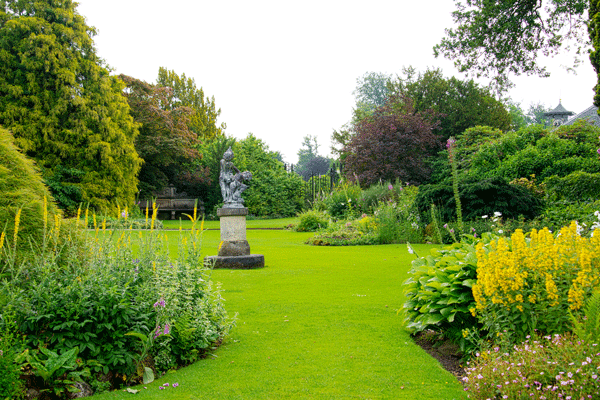
An article by Ian Hodgson that discusses the lawn in garden design
The design and development of domestic gardens has taken huge strides in the last decade, fuelled by significant cultural shifts in attitude to the creation of outdoor space, widespread concern about human-induced activities that now threaten the well-being of the planet, along with the perceived value that gardens and garden making can bring to the quality of modern life. Changes have also been driven by the rise of the professional garden designer and the development new horticultural, scientific, and recently, more environmentally supportive technologies and processes. The momentum has also been fuelled by widespread opportunities to present ideas and innovations through influential and high-profile public events, such as the RHS Chelsea flower show, through books, television programming and now more potently, through online via the internet and social media. The lawn has played and integral part of those changes.
Inauspicious beginnings
Two consecutive world wars wrought terrible consequences on gardens both large and small. Loss of estate owners, the professional staff that tended their grounds and ongoing post-war financial austerity meant many gardens went into serious decline or were severely curtailed to make them more economically viable.
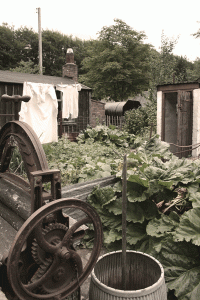
On the domestic front the extension of rationing until 1954 meant growing food continued to be of paramount importance. Ornamental plantings were then influenced by the colourful seasonal bedding plant displays seen in local parks grown in immaculate, weed-free borders surrounding rectangular or square closely mown lawns, striped with mathematical precision and edged with unswerving rigour. The received doctrine was all about achieving horticultural perfection and controlling, rather than nurturing nature. Post war advances in science, particularly the introduction of new pesticides helped gardeners enforce control.
As the heyday of some plant groups, such as alpines and rock gardening passed, others emerged, thanks to giant leaps in plant breeding and astute marketing to an appreciative public. Hybrid roses blossomed in the 1960’s thanks to the endeavours of flamboyant nurserymen such as Harry Wheatcroft and others, who brought long-flowering, disease resistant blossoms to brighten the lives of the public. Other plant groups suddenly finding favour were hostas, iris, hemerocallis, and hobby plants, such as chrysanthemums, dahlias and fuchsias.
Gardens in the 50’s and 60’s
Antithesis of the highly manicured, labour intensive approach to gardening was the cottage garden or more laissez faire approach to gardening championed by Margery Fish in her garden at East Lambrook. Her first book ‘We made a garden’ published in 1959 was the catalyst for a re-imagining of what gardening and garden-making could be, where plants were used informally and allowed to mingle or seed into gaps.
The approach was to edit the garden, rather than completely transform it each season, and her practical approach influenced a legion of new gardeners, particularly women.
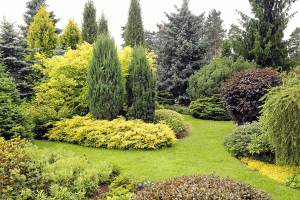
By the 1960’s nurseryman and plant breeder Alan Bloom had already popularised the perennial, introducing a range of new and exciting selections and hybrids at his nursery at Bressingham in Norfolk. In his 2.4ha (6 acre) Dell garden he also championed the island bed, a series of amoebic shapes cut into close-mown turf. When fully planted with perennials it enabled theatrical arrangements of plants to be included which could be viewed from all sides and the feature soon appeared in gardens throughout the land.
The 60’s and 70’s – a change in culture heralds a new style of garden design
Commercial developments in the 1960’s such as the introduction of garden centres helped the public more easily development of their own domestic spaces. Standardisation of composts and plastic containers also facilitated year-round purchase of container-grown stock. This said the financial downturn of the 1970’s also brought with it the closure of many established nurseries and the rationalisation of plant ranges. There was also a cultural move to reduce intensive maintenance so that owners had more freedom to enjoy their gardens.
Flowering deciduous and evergreen shrubs and conifers under planted with ground cover became de rigueur. The next distinctive style to influence garden design was championed by Alan Bloom’s son Adrian. At his garden Foggy Bottom in Norfolk he created island beds of striking and colourful conifers, under planted with a wide range of heathers and other ericaceous plants. The style captured public imagination, finding particular favour with male gardeners. The approach eventually fell out of mainstream favour due to its perceived lack of seasonal interest and plant diversity although its legacy can still be seen in many domestic gardens.
The 1980’s – when romance comes into the garden and lawn mowers become more user-friendly
By the 1980’s attention returned to an earlier ‘golden age’, particularly to the painterly plant combinations of Edwardian planting designer Gertrude Jekyll, who had decorated the grounds surrounding Arts and Crafts properties of Sir Edwin Lutyens.

Voluminous borders planted in colour-themed in pastel tones, or white gardens, influenced by the iconic example created by Vita Sackville-West at Sissinghurst Castle in Kent in 1950, soon became all the rage. Mixed borders filled with billowing perennials set among structural and flowering shrubs set against a backdrop of yew or box hedging also became popular, greatly influenced by the writings and plantings of Christopher Lloyd at Great Dixter, his home and garden in East Sussex.
Rustic decoration such as thatched or shingle-roofed garden buildings in Cotswold stone and accessories in woven willow and naturally rusted wrought iron helped give an air of decayed bucolic charm.
Coloured paints for outdoor use also launched, enabling garden owners to colour theme timber structures in their gardens for the first time. The range of plants was fuelled by the emergence of a range of small, specialist nurseries providing rare and unusual perennials and shrubs.
Other historical precedents were revisited. Prime among these was the potager, a formal and mathematical arrangement of beds which combined trained top and soft fruit trees. Vegetables and herbs set among decorative ornamental perennials and bulbs were staged for ornament as well as food.
Methods of maintaining lawns started to change with the introduction of new types of mowing machine. The cylinder mower continued to be improved in terms of efficiency, but the rotary and hover mower soon became the tool of choice for families wanting a utilitarian, hard-wearing surface suitable for family life. Improved seed mixtures also helped provide a greater range of fast establishing, hard-wearing blends.
The design revolution
The deliberate designing of domestic gardens started to gain credence among a new affluent community of homeowners. Previously, garden design was the preserve of those who could afford the services of a small retinue of professional designers. The catalyst for the domestic design revolution had started in 1969 with the publication of ‘Room Outside’ by emerging designer John Brookes, encouraging home owners to use their outdoor spaces more effectively and in tune with their respective lifestyles, and for the first time providing a range of ideas and inspiration on which to draw. This also included using of lawns as an element in its own right, by shaping the turf into circles, interlocking geometric shapes, or more free-form features or help provide emphasis to views and vistas.
The patio became the must have feature of the garden, a paved area whose prime purpose was all about leisure, for sitting and relaxing as well as entertaining or cooking outdoor food in barbeques or even outdoor kitchens or ovens. Garden lighting has also become far more sophisticated, enabling the patio to be used for entertaining at night, or providing dramatic illumination of plants or features.
The importance of lawns
The lawn has long remained an important aspect of the designed garden. From a practical standpoint it provides a soft, usable surface for recreation, including everything from sitting,sunbathing and play, including football and other active games. Along with the patio it is an important focus for family life, facilitating wider and more active communal interaction.
New varieties of turf grass have been deliberately bred and selected and then carefully blended to create swards that are variously hard wearing, drought and shade tolerant or produce a verdant surface that tolerates repeated close mowing.
As an aesthetic, the lawn provides welcome visual relief from busy plantings, the verdant monotone counterpointing powerful use of colour. Close-mown turf uniquely links disparate elements together, providing cohesion, unity and injecting a sense of purpose and intent to the design.
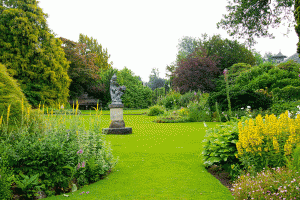
Molding the shape and outline of an area of turf can profoundly influence the way we engage, perceive and interact with the garden. Curvaceous or meandering outlines create a tranquil, peaceful effect, and if exaggerated will open and close views as you explore. Strongly geometric lines, such as squares or rectangles emphasise a sense of importance, and are often associated with defining spaces adjacent to buildings around which other elements, such as hedges, borders and architectural ornamentation are arranged.
A circular lawn acts as a focal point, centralising our vision of the space and is a useful way to disguise an awkward shaped plot. A narrow strip of lawn can act as a pathway, inviting exploration and drawing our gaze to a distant object or horizon. Alternatively it can act as a sight line, creating a vista to a focal point or far horizon.
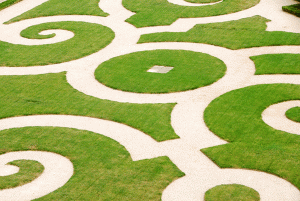
By playing with perspective through exaggerating narrowing or widening of turf pathways or vistas and careful placement of supporting elements, such as hedges or trellis you can create the illusion a distant object or view is further away or nearer than it actually is.
Turf readily lends itself to being used three-dimensionally
. It readily disguises awkward changes in level that would be difficult and expensive to manage with rigid paving. It can be used demarcate subtle changes of height where steps link a series of grass-covered terraces.
Taken to its creative zenith it can be used to create extraordinary features or land art, such as the sinuous landforms at ‘ The Garden of Cosmic Speculation’ by Charles Jenks in the Scottish borders, or the inverted pyramid in the Orpheus garden by Kim Wilkie at Boughton House in Northamptonshire.
Effects can be simple to create. The way the turf is cut will create pattern and drama. Crisp, geometric lines from a cylinder mower will reinforce architectural designs, or instill a sense of movement on the ground, while a rotary or hover mower will create a unified surface. Turf cut a varying heights can also be used to create an astonishing array of temporary effects, particularly when saturated with dew or dusted with frost. The interface of where long meets short is an exciting arena for development, particularly if the longer grass is diversified with naturalised bulbs, wildflowers or perennials and the shorter grass is kept flower free.
The design revolution gains momentum
The founding of the Society of Garden Designers in 1986 provided a focus for designers to meet and discuss ideas and philosophies of new approaches to garden design. Today its members are at the forefront of new and exciting approaches to designing gardens and their work in both the private and public domain is promoted through many lifestyle magazines and online.
The 1990’s: The rise of nature as inspiration
A more naturalistic approach to garden design started to emerge in the early 1990’s. The movements started in Europe, notably Germany and the Netherlands and the USA. Mounting concern about the need to reconnect with nature had fuelled interest in natural landscapes, native plant communities, as well as exotic assemblages of plants emulating nature.
In the UK an early pioneer of combining native and exotic plants according to their environmental needs was Beth Chatto. Through her influential books her garden at White Barn in Essex became a leading example of how to arrange plants, particularly perennials, for aesthetic effect while being in tune with prevailing conditions.
Leading the new new naturalist movement in Europe was Dutch nurseryman and plant breeder Piet Oudolf, who pioneered techniques of establishing broad swathes of long-flowered perennials and ornamental grasses, sedges and similar and related plants which by now had become a staple of ornamental nurseries and garden centres thanks to plant breeders in Europe, notably Germany and the USA. Oudolfs visually striking and distinctive plantings soon caught on thanks to high profile publicity through influential magazines and were widely adopted by a receptive public thirsty for something new.
From the 1990’s greater understanding of the ecological principles of plant establishment in more naturalistic communities has been led by Professor James Hitchmough and Dr Nigel Dunnett of the University of Sheffield, who staged a range of projects in the UK and elsewhere to demonstrate the principles in practice, culminating with major plantings at the London Olympic Park in 2012.
Jungle influences
Antithesis of naturalistic-style landscapes of temperate climates is the emergence of subtropical-style plantings using exotic looki ng large-leaved foliage plants and brightly coloured flowers of perennials and bulbs. International travel and foreign holidays had helped fuel interest and the desire to recreate the lush jungle look at home. Influential gardener Christopher Lloyd created an iconic subtropical garden at his home at Great Dixter in Sussex which was widely publicised. Also helping facilitate development was the widespread availability of large specimen palm trees, olive trees and shrubs imported from the nursery trade in Italy and Spain. Suitability of otherwise tender exotic plants such as palms, bananas and gingers was assisted by the selection of cold tolerant variants from higher elevations in their native homelands.
Gardens as a refuge for wildlife
There is now overwhelming scientific evidence that gardens are collectively an important refuge for wildlife, particularly insects, amphibians and birds which are under threat from the loss of natural habitat from intensive agriculture and urban sprawl. Flowering plants, both native and exotic, have also been shown to be important food sources for pollinators such as bees, butterflies and flies. With many pesticides now withdrawn for toxicological or financial reasons, gardeners have readily moved into maintaining their gardens without pesticides which is also beneficial for the wildlife they attract.
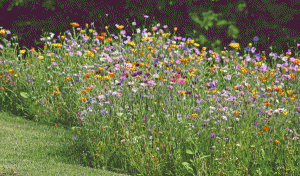
Wildflower meadows have recently become a focus of interest for designers, not just for wildlife, but as a way of providing valuable landscape in cash-strapped parks and open spaces at lower cost. In gardens the techniques used to achieve the effects vary from areas of turf being allowed to grow longer, perhaps enlivened with drifts of spring and summer flowering bulbs through to sowing mixtures of annuals or first-year flowering perennials or wildflower and grass seed mixtures. Improved understanding of how wildflowers survive long term in grassland communities has improved the reliability of seed mixtures for both amateur and professional use. To make the process even easier turf producer Q Lawn in Norfolk has developed grassland ready sown with a range of reliable wildflower species and suitable for various sites and situations.
It has been an exiting period in the evolution of garden design over the last 70 years, where the emphasis has shifted from large estates to small domestic plots. The gardening public now create gardens that are better suited to their needs and lifestyles and instead of wanting to control or even kill nature, they now welcome it with open arms.
Save
